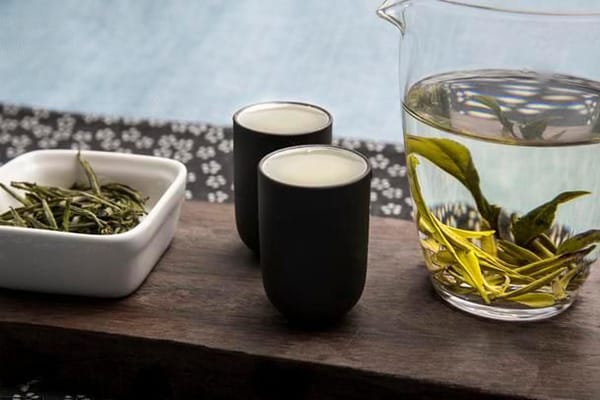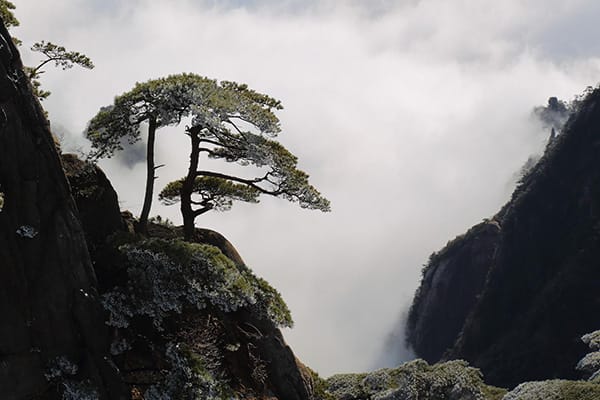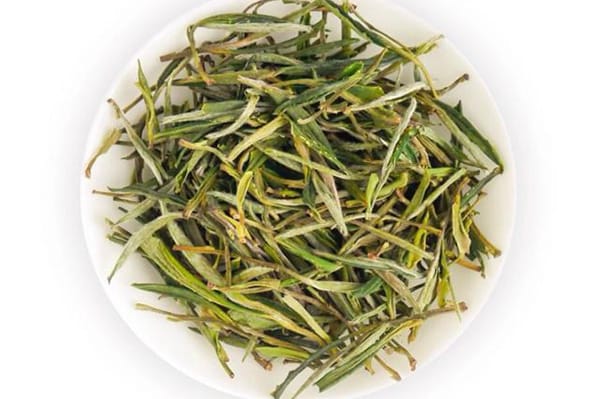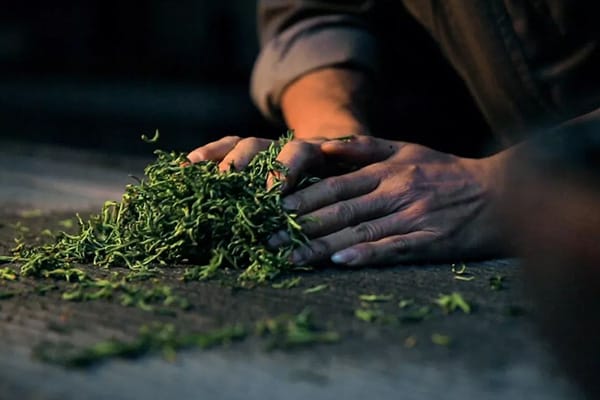Last Updated on 06/14/2022 by Desmond
High-quality tea always comes from a good natural environment. Huangshan, one of 10 famous Chinese mountains, fog covers all around, and strange pine trees grow alone on the steep hills. Poets and tourists praised this unique scenery since the old time. Villages under the mountain, folks running small and big tea plantations. A tea regarded as “the fairy of the tea” – Huangshan Maofeng is from here.
CONTENT
About Huangshan Maofeng
What Is Maofeng Tea
All among various Chinese famous teas, many are called Maofeng, such as Emei Maofeng, Meng Ding Maofeng, and Huangguoshu Maofeng. Mao is to describe the tiny white fuzz on the leaves, and Feng means Mountain, which refers to the tea that comes from the Mountains at a high altitude. So some tea shops also call Huangshan Maofeng as Huangshan Fur Peak Tea.
Huangshan Maofeng is the most famous one. It belongs to the non-fermented green tea, originated in Huangshan Mountain, Anhui. Its leaves show a jade green, little curly like the bird’s tongue. A small yellow leaf which too late to bloom is beside the bud and called “Golden Piece.” A delicate plant’s scent given from the dried leaves smells like the orchid.
Producing Regions
Many excellent teas are from Anhui, like Keemun Black Tea, Taiping Houkui, Huoshan Huangya, and Lu’an Gua Pian. As the most famous geographical indication of Anhui, the natural environment of Huangshan is no doubt the best. It is about 1800m altitude, “strange pine tree, weird stones, cloud sea, and hot spring” are the characteristic landscape here.
The hills here are high to the moon, with a thick fog; if you climb to the top, you may feel like standing on the cloud. Dangerous and steep hills like this can not impede the plants growing; pine trees clung tenaciously to lives on the rock, looks like the mythical immortals.
Of course, Huangshan Maofeng is not planted in such a high place; to harvest will be a problem. Tea plantations are located at the hillside at about 800m altitude, where the climate is more comfortable. Tangkou, Gangcun, Yangcun, Fangcun are the 4 main top-grade Huangshan Maofeng producing plantations, honored as “4 great families.”
The temperature still cold here, the annual average only 15-16℃, rainy and moist. There’s a local folk saying, “good tea comes from the high and foggy mountain.” The annual sunshine duration is very short because of the fog reason, tea trees would not be hurt from the fierce sun and can accumulate the nutrient better; thus, it can create an awesome flavor.
History
Huangshan has a long tea-producing history. The Chinese tea culture was most prosperous in the Tang Dynasty; the tea style was block tea. In Song Dynasty, the local tea masters added the rolling step in the green tea processing, shaping the leaves a beautiful appearance.
The plantations are covered by fog all year long. So the teas produced here are also called Huangshan Yun Wu Tea, which is regarded as the predecessor of Huangshan Maofeng.
According to the local chronicles, Huangshan Maofeng was invented by Mr. Xie Zhengan, the founder of Xie Yu Da Tea Shop in the Qing Dynasty (about 1875).
At that time, he wanted to satisfy the market requirement better. So he picking sources leaves from the Tangkou and Chongcun plantations, then processing in great green tea by the optimized methods, and name it Maofeng.
In the past, Maofeng tea ever spread worldwide through the Maritime Silk Road and got fame. Unfortunately, Xie Yu Da Tea Shop was a decline in the 1920s because of bad management. But that did not have any bad effect on the Maofeng tea; it developed into a public brand increasingly and renamed Huangshan Maofeng officially. In 1955, Huangshan Maofeng was rated as one of the ten Chinese famous teas.
Camellia Sinensis Varieties
Tianhu tea plantation, where was Mr. Xie Zhengan set up in Chongcun village at that time, was regarded as the birthplace of Huangshan Maofeng. All the tea trees planted here are the Huangshan native species – Huangshan species. It is a bush, big-leaf type Camellia Sinensis, with a long growth cycle and can accumulate more nutrients.
Over 100 years have passed, these tea trees are still living tenaciously. But due to their buds sprout late that can not catch up with the spring tea publish time. So, most of them have been forgotten in the deep forests, only a few tea masters picking leaves from them for the pre-order by the senior tea lovers.
In most tea lovers’ minds, the newborn bud tea in spring is always the best. I cannot say that is wrong. Chinese classified the teas according to the traditional solar term, like Mingqian Cha(harvest before 5th, April) and Yuqian Cha(harvest before 20th, April). The Huangshan type Camellia Sinensis is exactly sprouting during this time. Still, it is almost impossible to hit the market by these dates.
Thus, just like other famous green tea-producing regions, the Huangshan tea plantations also introduced Wuniu and Hongqi species tea trees, which are sprout earlier. Their leaves also taste fantastic, but they are not resistant to brew due to the small-leaf reason.
Processing
The processing of Huangshan Maofeng tea is not so difficult as other teas, but it is also quite characteristic. Just like traditional green tea processing, primarily been through picking, fixation, rolling, and drying.
Picking
Huangshan Maofeng’s primary harvest time is in April; some early sprout tea trees even can start picked in mid or late March. Harvest job end at Lixia(5th, May). According to the picking standards, Huangshan Maofeng is classified into the following grades:
- Top Grade – One bud and the just bloom first-leaf;
- First Grade – One bud and to the just bloom second-leaf;
- Second Grade – One bud and to the second-leaf;
- Third Grade – One bud and to the third-leaf;
The most significant feature of the Top Grade Huangshan Maofeng is the just-bloom first-leaf of it, which shows yellow and is called as “Golden Piece.”
About this first-leaf, some people thought it is the resulting from the tea trees accumulating rich nutrients in winter. And some others thought that might because of the dehydration during processing and turn yellow. Undeniable, the Huangshan Maofeng with “Golden Piece” is indeed harvested before Qingming.
Fixation
Fresh leaves will be fixating immediately after picking to stop them from going on natural fermentation. The most traditional way is to put the leaves in a special iron bucket, with charcoal fire heating, and keep shaking it. Leaves rolling inside the bucket till they lost gloss. That’s got the same theory with the modern fixation machine, but the modern one is electric and automated. Some tea masters also take a more common method, such as pan-frying for fixation.
Rolling
Most green teas will be sent to a pan under low temperature for rolling after fixation. But in Huangshan Maofeng rolling processing, leaves after fixation will be placed on slate or a bamboo sieve, rolling slowly by tea masters. The operation should be gentle not to let the fuzz drop down and make the leaves lose their value.
Drying
Finally, leaves must be drying. Tea masters place the leaves on a special bamboo cage, with charcoal fire below, drying them slowly until the water content reduces to about 15%. Some traditional tea masters will use a wooden cabinet instead of a cage for the roasting job.
Further Processing
Leaves that have been through all the above 3 steps are called rough tea, which is done in tea masters’ families. But the water content and quality are still far away from the market standard. So the tea factories will purchase these rough teas for further processing – screen, reroast, and so on, then package for sale.
How Does Huangshan Maofeng Tea Taste Like
Huangshan Maofeng dried leaves’ appearance is not so attractive; they show jade green, curly into strips. Because of the just bloom first-leaf, they retain some tea stems inevitably. If brewing it with a glass cup, you can see the leaves bloom in water slowly, along with the rising steam, just like a beautiful fairy dancing.
The infusion of Huangshan Maofeng tea shows a light yellow, clean and bright. The fragrance is not obvious; it is a delicate orchid aroma, elegant and fresh. Because of the roasting drying, there also some fried beans aroma mixed in the floral.
Take a little sip, it’s a brisk and smooth mouthfeel, and the orchid scent becomes more obvious. It tastes a little bitter, astringency, and roasted chestnuts; about two seconds later, a slight sweetness aftertaste comes.
On the whole saying, Huangshan Maofeng tea has a very light and quiet flavor, so the ancient Chinese ever described it as “the fairy of the tea.” To the people who need a peace mind on meditating or studying, Huangshan Maofeng will be a nice tea.
How To Make Huangshan Maofeng Tea
- Prepare and preheat a 300ml white ceramic Gaiwan;
- Put 3-5g leaves in, then add 85℃ water in on a ratio of leaves to water 1:50;
- Cover and steep for about 20 seconds;
- Pour the infusion into a fair cup to equal the concentration;
- Share to every cup and enjoy;
Most Huangshan Maofeng teas on the market are not from the native species tea trees, so that they typically not resistant to brew. After the first brew, every following round can extend about 20 seconds of steeping time. Still, it will lose all the flavor after the fifth brew.
Storage Way
Huangshan Maofeng is a non-fermented green tea; typically, it’s not suitable for long-time storage. The recommended expiration date is also 12-18 months. Even though it exceeds the date limit, the flavor will not have a significant change soon; but you still need to finish it ASAP. During the Huangshan Maofeng storage, the following points should be taking care of:
Airtightness. If the tea you bought is with an individually sealed package, you don’t need to worry about the airtightness problem. But if it is a big package, once you unwrap it and take the leaves out, you need to squeeze all the air out as you can then seal it OK again. Or choose a suitable container for storage.
Related Reading: Choose the best tea storage container for loose leaf tea.
Keep Dry. The dried leaves are easy to absorb the water in the air. After ensuring the airtightness of the package, you still need to take care of the ambient humidity, avoiding the leaves get damp and moldy.
Low Temperature. Huangshan Maofeng tea is suitable to store at a place under 5℃; a fridge looks a good choice. Suppose you are going to store the tea in the fridge. In that case, it will be better to do with a container, even though it had already had an individually sealed package. Besides, check the smell from other foods in the fridge, whether it is serious, avoiding the leaves’ flavor get polluted.
Keep Dark. To the non-fermented or light fermented tea, the sunshine is a risk which easy to be ignored. A long time of direct sunlight will make the leaves photochemical reactions, lead to loss the color and flavor. Besides, it also leads to a high-temperature problem.






